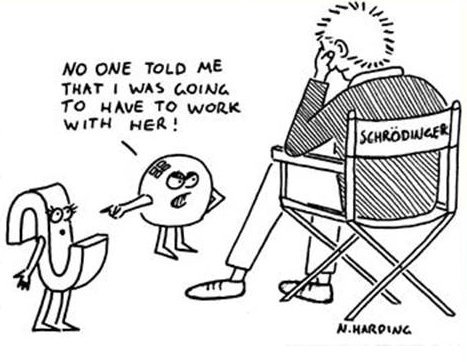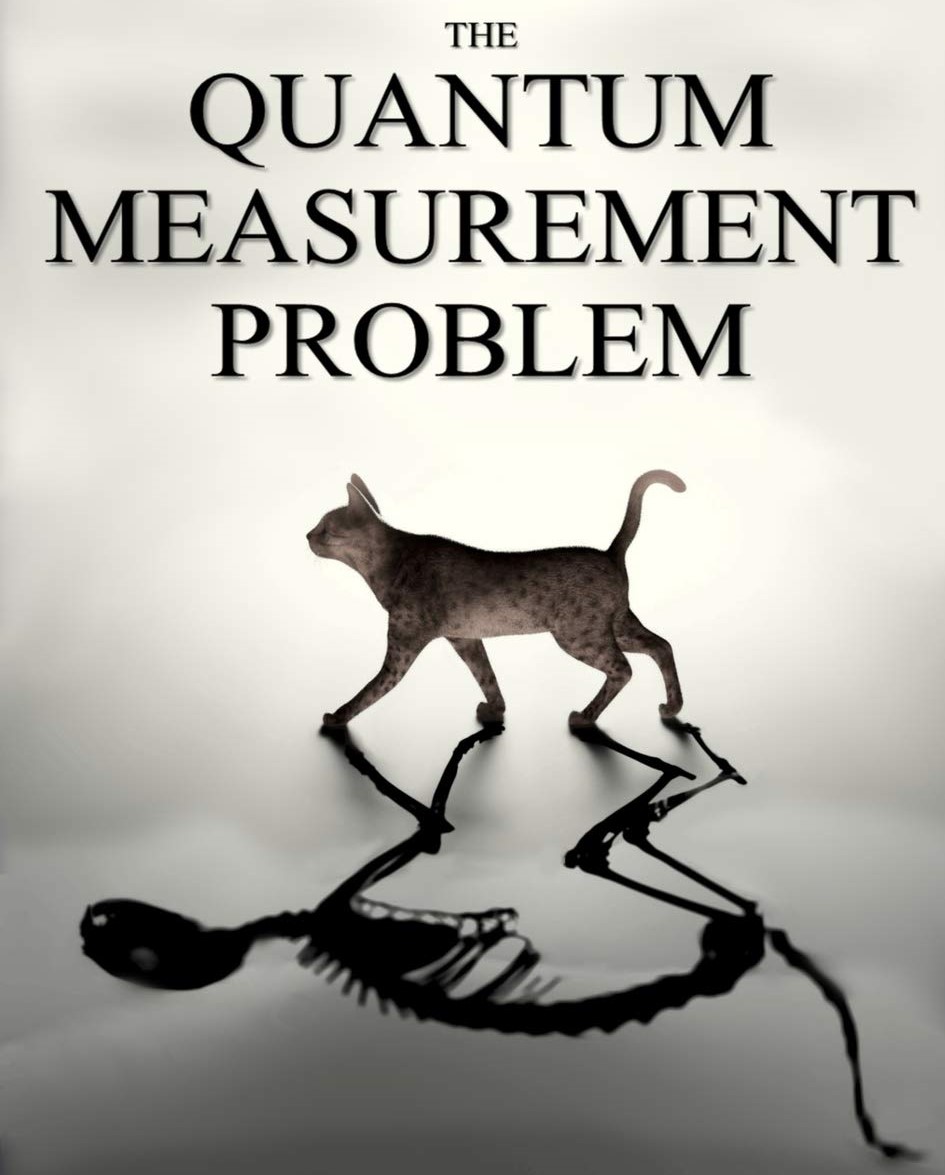The quantum world is a mystery in itself. There is no path you can take that does not end up in an enigma. These puzzles are solved only after a gruesome battle with our common sense, where it is beaten to a pulp, and we are obliged to alter our perception of the world. Fasten your seatbelts and hold on tight, because we are about to roll on a journey on the roads of quantum “weirdness” which is sure to cause nausea and also might test the airbags of your brains. If you have motion sickness called “I believe in determinism” or “I hate quantum stuff”, disclaimer: this article might make you sick and cause you to throw up. You have been warned…
Wave-particle Duality

The duality is always presented as a puzzle, a dilemma, a paradox or even a contradiction: always as something to be overcome and done away with. This idea has changed the whole notion of understanding of quantum theory. Particle theory could not explain thoroughly established facts of interference.
German physicist Albert Einstein first showed (1905) that, what had been considered a form of EM waves, must also be thought of as particle-like. In 1924, French physicist Louis de Broglie came with the wave nature of electrons. Wave nature of electrons was experimentally entrenched by American physicists Clinton Davisson and Lester Germer and independently by English physicist George Paget Thompson.
So the duality, even though it seems to be absurd, is the fundamental picture of the universe. And has to be duly accepted. Even if it has to be accepted, it is still difficult to comprehend the real nature of the quantum world, with its both wave and particle properties.
Copenhagen Interpretation
This interpretation was authored by Niels Bohr and Heisenberg in the 1920s. In this strange quantum world, a quantum particle exists in every possible state it can exist simultaneously. But when we try to observe, it the wave function collapses and we can only see one state. The Wave function is unobservable and the predictions are probabilistic and what makes the function collapse is mysterious.
This state of existing simultaneously in all possible states at once is called an object’s Coherent Superposition. For example, photons that exist in both wave & particle form that travel in both directions at once-makes up the object’s wave function. When we observe a quantum object, the superposition collapses and the object is forced into one of the possible states of its wavefunction.
Schrödinger’s Cat
We all have heard of Schrodinger’s famous diabolical thought experiment which he proposed in 1924. He set up a Geiger Counter in a box along with a bit of radioactive substance and put his cat in that box. The counter was designed so that when it sensed the decay of the radioactive material, it triggered a hammer which was poised to break a flask containing hydrocyanic acid, which when released, would kill the cat.
To avoid any certainty regarding the cat’s fate, the experiment was to take place within an hour. This was long enough so that some of the radioactive material could possibly decay, but short enough so that it was also possible none would.
The cat was sealed in the box, and it came to exist in an unknowable state. The cat was alive and dead at the same time until we observe it. It’s sort of like quantum physics’ answer to the old Zen question: If a tree falls in the woods and no one is around to hear it, does it make a sound?
Many worlds interpretation
This theory was originated from Hugh Everett’s thesis which he had done under the guidance of John Wheeler which has bedeviled physicists since the 1920s. He was a brilliant mathematician and iconoclastic quantum theorist. This theory was quite ignored by everyone. It is the most cunning, enchanting and thought-provoking theory in all of the ways which quantum mechanics has been interpreted.
Everett was saying that it’s our concept of reality that’s at fault. We only think that there’s a single outcome of measurement because we only see one of those realities. But, the others have a separate physical existence too. He was trying to purport that the entire universe is described by an enormous wave function that contains it all possible realities. This “Universal wave function”, as Everett wrote it in his thesis.
The wave function is a mathematical expression that provides information about a particle’s all possibilities of location and its characteristics. Begin as a combination or superposition of all possible states of its constituent particles. As it evolves, superpositions break down, making certain realities distinct and isolated from one another. Worlds are not ‘created’ by measurement; they are just separated.
Many worlds interpretation and multiverse are totally different concepts. The multiverse is a hypothetical collection of myriads of observable universes containing different realities. Where MWI holds that there exist many worlds in parallel to our world in the same space and time as our own. In every event that happens in the quantum world, the world splits into all possible realities.
Decoherence And Quantum Problem
Decoherence is simply the loss of coherence in which the wavelike states of a Quantum system become uncoordinated and scrambled by their interactions with their environment. The waviness of particle gives rise to quantum effects like Superposition, entanglement and interference.
Decoherence, therefore, destroys these fundamentally quantum properties and the states start to behave more like distinct classical systems. Macroscopic objects don’t display quantum interference or exist in a superposition of states because their wave functions are decoherent.
Once the parallel quantum worlds have decohered, they spit and they lose causal influence on one another. Decoherence removes all interference between universes.
Quantum coherence is essentially what permits ‘quantumness’.The object remains in a coherent state until we measure it. Measurement somehow destroys quantum coherence.
Wigner’s thought experiment
In a famous ‘Wigner’s thought experiment’, Wigner put his friend Will in the laboratory with 0/1-measurement on the physical system. The superposition state of the lab is then a linear combination of ‘System is in state 0/ friend has measured 0’ and ‘System is in state 1/ friend has measured 1’. Winger’s idea can be used to formally prove that measurements in quantum mechanics are subjective to observers. There are observer-dependent theories like Quantum Bayesianism-agent’s actions and experiences are central concerns of the theory.
Whichever answer his friend gives Wigner would then assign the state. But he realized about his friend’s result that the superposition state of the laboratory collapses.
From his friend’s point of view, the measurement result was determined long before Winger had asked about it. And in turn the state of the physical system has already collapsed. Now the question is when exactly did the collapse occur?
Von Neumann’s catastrophe of infinite regression
Why there is something definite when we look at decoherence? Whatever particles were used to collapse another, what was used to collapse that particle? and so on.
The reason behind this is the wavefunction of a particle cannot be unentangled from whatever we used to measure by another they entangle. If one particle measures another, it inherits part of its wave function and that particle which is supposed to be measured cannot be fully explained without what it is measuring.
So we need another measuring device to collapse that initial measuring particle to a definite state. But then we need something else to collapse that measuring apparatus as well and so on. This creates a chain of material objects in a superposition of measuring which is known as a Von Neumann Chain.
We here need something nonlocal, outside the entire material system, which escapes this chain by not being bound by the same physical laws. A conscious observer is able to cause the final collapse of everything in the chain. A non-physical conscious observer is not required to explain the collapse of the wave function. Quantum system and its environment are always given purely with no true collapse.
What is happening with particle when it is going through a double-slit experiment is still a mystery. Which path particle took and why? Why wave function collapses? or is this all just about consciousness. Everyone has proposed their epistemological theories and put wondrous and capricious questions in front of the world. As Richard Feynman said “Double-slit experiment has in it the heart of quantum mechanics. In reality, it contains the only mystery.”
Atomic Dhruvi
Physics is never ending science, and science has never ending problems. Find out more about this here.




This website was… how do I say it? Relevant!! Finally I’ve found something that helped me.
Many thanks!
Good post. I absolutely appreciate this site. Stick with it!
[…] the remainder(r) when divided by N and save it. We can’t measure directly because of the Quantum Measurement problem that would destroy the superposition. So we measure only the remainder ‘r’ of the saved […]